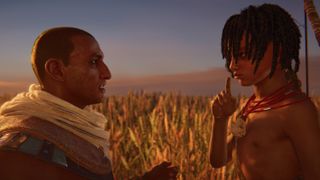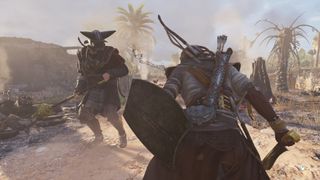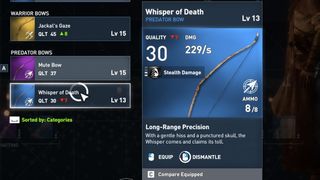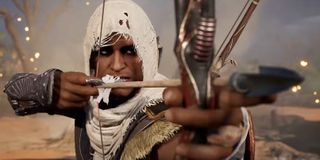8 things I wish I knew before playing Assassin's Creed: Origins
Use your torch to light arrows on fire, set traps to prevent reinforcements, break down your weapons for crafting resources, and more.

I'm still working my way through Assassin's Creed: Origins, and I'll have a full review in a few days (my review in progress can be seen here in the meantime).
I estimate I'm about two-thirds through the game, and with much of the world explored and a bloody handful of assassinations under my belt, I've got a few nuggets of wisdom for you in the form of things I wish I knew before I started playing.
You can tell if you'll be able to kill someone before you try to kill them
As an assassin, one-hit kills are your bread and butter. So, it's handy to know in advance if you'll achieve one or if your target will be stubborn about going to the grave. Origins is nice enough to give you that information.
As you can see in the gif above, while lining up a bowshot, you can essentially see the future state of your enemy's health bar. If it's all red, it means that the single shot you're about to make will kill them. If there's some white left in the meter, it means your shot will just wound them. Also note that where you aim matters: the same arrow aimed at that guy's shoulder shows a little health will remain after he's hit, while aiming at his head predicts a complete kill.
The same goes for sneaky assassinations using your wrist blade. When you're close enough to stab your mark, you'll be able to tell if you're about to engage in a quick, quiet kill, or a prolonged struggle.
You can set arrows on fire with your own torch
There's a couple ways to set your arrows on fire in Origins. You can creep over to a lit brazier, or fire an arrow over an open flame at an enemy. Those require a source of fire that may not be terribly convenient, however, especially if you're in a nice hiding spot and don't want to scuttle out of it.
Luckily, you always have a torch in your inventory, and that torch can be dropped at your feet. Origins doesn't tell you this, but you can then use that grounded torch to set the tip of your arrow on fire. Just plop the torch down and draw your bow close to it, and voila.
PC Gamer Newsletter
Sign up to get the best content of the week, and great gaming deals, as picked by the editors.
Red skull icons aren't messing around

Tagging enemies displays their level, and if they're a higher level than you, that icon will be red. It doesn't mean you can't take them on, just that they'll be tougher and you'll have to work harder to bring them down.
However, if they're a few extra levels above you, you'll see a red icon with a skull. That means, basically, you're not even in the same league as your enemy. Initially I thought, so what? So he's maybe five or ten levels above me: he's still a standard guard made of meat and I still have a bunch of pointy objects to stick into him.
Origins doesn't work like that. Trying to chisel away his heath meter was like trying to melt an iceberg with a single matchstick, and the weapons that had been so easily carving up goons suddenly seemed to be made of foam. Meanwhile, they hit you like a train, and the train hasn't been invented yet. Steer clear and come back later. Much later.
You can dismantle your weapons for parts

It took me a while to realize this, but as you find or buy higher level weapons, you can convert the old ones into crafting ingredients. This can be a time saver: if you find yourself short a few sticks of wood or metal, you may be able to skip a hunting trip or convoy ambush and just strip some of your old gear for parts, then use those resources to improve your armor, quiver, or assassin's blades.
You can booby trap braziers
When enemies call in reinforcements, it doesn't just mean more soldiers will arrive. The guys who answer the call are Phylakes, soldiers who are tough as nails and should be avoided whenever possible. So, when infiltrating a camp or fort, you're going to want to prevent enemies from lighting their brazier to call for help.
Completely avoiding detection as you stab your way through the guards is the best way to do this, but you still want to hedge your bets. If you can safely reach the brazier itself, you can rig it with a trap. Then, if you're spotted later, the dope trying to light the signal will not only be dead, but the brazier itself will be destroyed. Two birds, one explosion.
You're vulnerable while using eagle vision
At just about any time in Origins, you can look through the eyes of your eagle pal, Senu. This is immensely cool and useful for scouting, spotting threats, tagging enemies, and targeting objectives. While your brain is in the eagle, though, don't forget you still have a human body, and that body stays right where it is, vulnerable to discovery and attack.
Or, in this particular example, vulnerable to fire. I'd crabwalked to the edge of a tower, but didn't notice I was right up against a lit brazier. While my brain was in Senu, my clothes caught on fire. Whoops! The master of stealth, ladies and gentlemen.
There's a great photo mode

I was a several hours in before I noticed a photo mode listed in the keybindings. We here at PC Gamer love games with photo modes, and Origins lets you pause the action with the F3 key, move the camera around in the 3D space, apply filters, and take some nice shots.
Other players can see your photos

It took me a while to notice this, too. On your map you'll see some small rectangles, which represent the photos taken by other players. It's nice to see what your friends are up to, where they've been, and what they've seen.
Just, um, keep in mind they'll be able to see what you're taking pictures of too. I found myself a little embarrassed because all I'd been doing with the photo mode was taking pictures of me running over pedestrians with my horse. Seriously, I had probably twenty pictures of me trampling pedestrians scattered around the map before I realized other people could see them. Plus one picture of a goat watching a dog pee on the side of a building. If I'd known my friends could see my vacation pics I might have taken some nicer ones.

Chris started playing PC games in the 1980s, started writing about them in the early 2000s, and (finally) started getting paid to write about them in the late 2000s. Following a few years as a regular freelancer, PC Gamer hired him in 2014, probably so he'd stop emailing them asking for more work. Chris has a love-hate relationship with survival games and an unhealthy fascination with the inner lives of NPCs. He's also a fan of offbeat simulation games, mods, and ignoring storylines in RPGs so he can make up his own.
Most Popular



